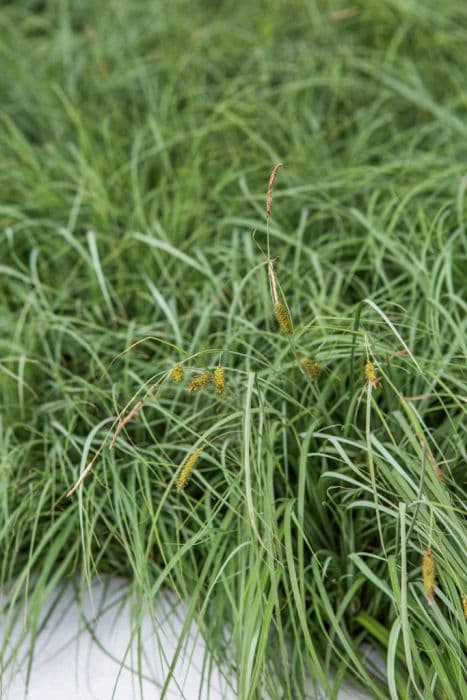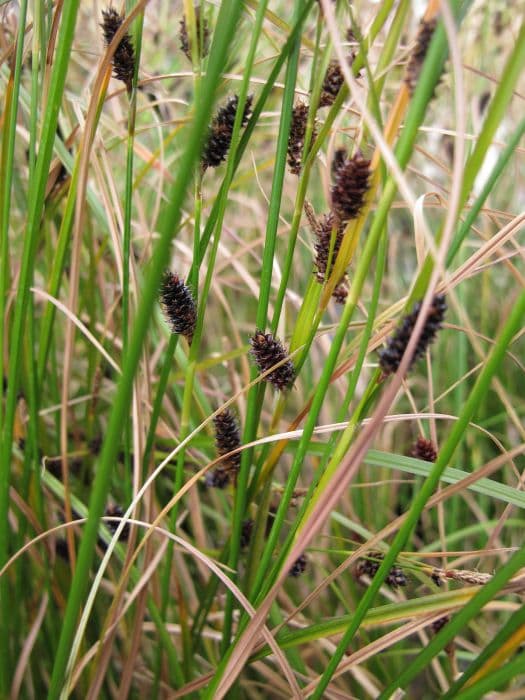Weeping Sedge Carex flagellifera











ABOUT
Carex flagellifera, commonly known as weeping brown sedge, exhibits a distinctive appearance that adds texture and color to garden landscapes. This plant boasts graceful, arching foliage that has a fine texture, giving it a delicate and feathery look. The leaves display a rich color palette, ranging from green to bronze, and may shift in hue with seasonal changes, contributing an ever-evolving visual interest throughout the year. The overall form of weeping brown sedge is tufted and clump-forming, creating a dense and bushy presence in its growing spaces. Its foliage cascades down, creating a weeping effect that can soften the edges of garden beds or pathways. This draping characteristic is particularly attractive and can be used to contrast with more upright or structured plants in a garden setting. During its blooming period, the plant produces inconspicuous flower spikes. These flowers are not particularly showy and tend to blend in with the overall texture of the plant. After flowering, small seed heads may form, but again, these are quite subtle and do not typically draw much attention. The weeping brown sedge is a hardy plant and is often chosen for its ability to add a fine-textured, weeping element to gardens without demanding significant ongoing care or maintenance. Its color, texture, and growth habit make it a popular choice for a variety of landscape designs.
About this plant
 Names
NamesSynonyms
Weeping Sedge, Tangle Sedge, Whipcord Sedge
Common names
Carex flagellifera var. rupicola, Carex colensoi, Uncinia colensoi, Uncinia flagellifera.
 Toxicity
ToxicityTo humans
Carex flagellifera, commonly known as weeping brown sedge, is not typically considered toxic to humans. There is no widespread documentation on the toxicity of this plant, indicating that ingesting it is unlikely to result in significant poisoning. However, it is generally advisable to avoid ingesting plants that are not known to be edible due to potential for individual allergic reactions or irritation. If symptoms do arise from ingesting Carex flagellifera, it is recommended to seek medical advice.
To pets
Carex flagellifera, or weeping brown sedge, does not have a reputation for being poisonous to pets. There is a lack of evidence regarding significant toxic effects of this plant on animals. Nonetheless, as a general precaution, the ingestion of non-food plants by pets should be discouraged as it can sometimes lead to gastrointestinal upset or other individual reactions. If a pet exhibits symptoms after consuming parts of this plant, it would be prudent to consult with a veterinarian.
 Characteristics
CharacteristicsLife cycle
Perennials
Foliage type
Evergreen
Color of leaves
Varies
Height
2 feet (60 cm)
Spread
2 feet (60 cm)
Plant type
Herb
Hardiness zones
8
Native area
New Zealand
Benefits
 General Benefits
General Benefits- Ornamental Value: Carex flagellifera, commonly known as weeping brown sedge, offers a distinctive bronze to reddish-brown foliage that adds color and texture contrast to gardens and landscapes.
- Low Maintenance: This plant is known for its low maintenance requirements, making it an ideal choice for gardeners looking for hardy, easy-care plants.
- Erosion Control: The fibrous root system of the weeping brown sedge helps to stabilize soil and prevent erosion, particularly on slopes or in areas prone to water runoff.
- Habitat for Wildlife: The dense clumps formed by this sedge provide shelter and nesting opportunities for birds and small animals.
- Drought Tolerance: Once established, Carex flagellifera can tolerate periods of drought, making it a suitable option for water-wise gardens or regions with low precipitation.
- Soil Improvement: This plant can help to improve soil structure over time through its root network and organic matter contributions from decaying leaves.
- Versatility in Landscaping: Weeping brown sedge can be used for a variety of landscaping purposes, including ground cover, border plantings, and as an accent in rock gardens or around ponds.
- Seasonal Interest: The plant's foliage provides year-round interest, especially during autumn and winter when the leaves turn a rich reddish-brown color.
- Supports Biodiversity: By adding this native plant to a garden, it can support local ecosystems and promote biodiversity.
- Tolerance to Various Soils: It is adaptable to a range of soil types, from sandy to clay soils, albeit preferring well-drained conditions.
 Medical Properties
Medical PropertiesThis plant is not used for medical purposes.
 Air-purifying Qualities
Air-purifying QualitiesThis plant is not specifically known for air purifying qualities.
 Other Uses
Other Uses- Carex flagellifera, commonly known as weeping brown sedge, can be used to create natural woven baskets due to its strong and flexible leaves.
- The plant can be planted along water features in gardens to provide an aesthetic edge that blends well with water plants and stones.
- Weeping brown sedge can serve as a microhabitat for small insects, offering shelter and food within its dense foliage.
- It can be used as a means to control erosion on slopes as its root system helps to stabilize the soil in such areas.
- In floristry, Carex flagellifera may be incorporated into flower arrangements for its unique texture and color contrast.
- Dried leaves of weeping brown sedge can be utilized for crafting purposes, such as in the creation of decorative mats or wall hangings.
- This plant can serve as a natural mulch due to its dense growth habit, helping to retain moisture and suppress weeds around other garden plants.
- Gardeners can use Carex flagellifera to create a "soft edge" transition between manicured lawns and wilder parts of the garden.
- It can be used in garden design to create contrasts with plants that have different foliage colors or textures.
- Weeping brown sedge is sometimes used in theme gardens, such as Japanese or rock gardens, for its form and natural movement in the breeze.
Interesting Facts
 Feng Shui
Feng ShuiThe Carex flagellifera, commonly known as Weeping Brown Sedge, is not used in Feng Shui practice.
 Zodiac Sign Compitability
Zodiac Sign CompitabilityThe Weeping Brown Sedge is not used in astrology practice.
 Plant Symbolism
Plant Symbolism- Resilience: Carex flagellifera, commonly known as Weeping Brown Sedge, often grows in challenging conditions such as boggy and marshy lands, symbolizing the ability to thrive amidst difficulties.
- Adaptability: This plant's capacity to adapt to various environments represents flexibility and the readiness to adjust to changing circumstances.
- Protection: The dense growth habit provides shelter for wildlife, representing safety and protection to those in need.
- Modesty: As a non-showy grass-like plant, Weeping Brown Sedge symbolizes humility and understated elegance.
- Growth: The spreading nature of the plant signifies personal growth and expansion of one's boundaries.
 Water
WaterThe Weeping Brown Sedge prefers consistent moisture and should be watered regularly, especially during dry periods. Water the plant thoroughly once a week, providing about one gallon of water per square foot to ensure the soil is moist but not waterlogged. During hot summer months or in particularly dry climates, increase watering to twice a week to maintain soil moisture. Reduce the amount of water during the winter months when the plant’s growth slows down. Make sure to water the soil directly, avoiding wetting the foliage to prevent fungal diseases.
 Light
LightWeeping Brown Sedge thrives in full sun to partial shade. The ideal spot for this plant would be an area where it receives morning sunlight and some afternoon shade, particularly in hot climates, to protect it from the harsh midday sun. However, it can also adapt to relatively shady spots, making it versatile for different garden settings.
 Temperature
TemperatureWeeping Brown Sedge can tolerate a wide range of temperatures but performs best in conditions between 60 and 75 degrees Fahrenheit. It can survive minimum temperatures down to around 20 degrees Fahrenheit but should be protected from prolonged freezing conditions. In the ideal temperature range, the plant will produce the best growth and maintain its attractive foliage.
 Pruning
PruningPruning Weeping Brown Sedge should be done to remove dead or damaged foliage and to maintain its tidy appearance. Prune in late winter or early spring before new growth begins, cutting back the foliage to about 4 inches above ground level. This will encourage fresh, new growth and improve the plant's vigor. Pruning once a year is generally sufficient for the health and aesthetics of the plant.
 Cleaning
CleaningNot needed
 Soil
SoilThe Weeping Brown Sedge prefers well-drained, moisture-retentive soil with a slightly acidic to neutral pH range of 5.5 to 7.0. A good soil mix can include peat moss, loamy garden soil, and sand or perlite to facilitate drainage.
 Repotting
RepottingThe Weeping Brown Sedge should be repotted every 2-3 years to refresh the soil and accommodate root growth. During repotting, divide clumps to propagate new plants if desired.
 Humidity & Misting
Humidity & MistingThe Weeping Brown Sedge thrives in moderate to high humidity levels but is adaptable to various humidity conditions as long as the soil moisture level is maintained.
 Suitable locations
Suitable locationsIndoor
Provide bright light and moist soil for indoor Weeping Brown Sedge.
Outdoor
Plant Weeping Brown Sedge in part shade and keep soil moist.
Hardiness zone
7-10 USDA
 Life cycle
Life cycleCarex flagellifera, commonly known as weeping sedge, kicks off its life cycle from seed, which upon germination gives rise to a seedling under favorable conditions of moisture and light. The seedling then develops into a clump-forming perennial with long, narrow leaves and a distinctive weeping habit. As the plant matures, it forms a dense tussock and in spring to summer, produces upright or slightly arching flowering stems called culms, bearing brown flower spikes. Once pollinated, usually by wind, the flowers develop into small fruit called achenes, which are then dispersed to give rise to new plants. In the right conditions, weeping sedge can also spread by rhizomes, forming colonies. Over time, older clumps may die out from the center, signaling a stage where division can rejuvenate the plant and help maintain its vigor.
 Propogation
PropogationPropogation time
Spring-Early Summer
The most popular method of propagation for Carex flagellifera, commonly known as weeping brown sedge, is by division. Division is best carried out in the spring as the weather starts to warm, which encourages rapid growth and recovery. During this process, a mature clump is carefully dug up and the root ball is divided into smaller sections, each with a good portion of roots and shoots. These sections are then immediately replanted in moist, well-drained soil at the same depth they were originally growing. Care should be taken to space the divisions about 12 to 15 inches apart (approximately 30 to 38 centimeters) to allow for ample growth. Regular watering after planting is essential to help establish the new plants.





![Japanese sedge [Everest]](/_next/image?url=https%3A%2F%2Fplants-admin.emdemapps.com%2Fimages%2Fplants%2F%2Fimages%2F604b5b6de0548.png&w=640&q=75)



